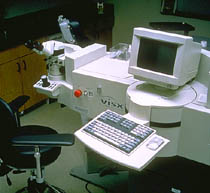The health, safety and well-being of our patients remains our top priority during the COVID pandemic. The UCSF Department of Ophthalmology is implementing a recovery plan to resume patient clinical and surgical care while making every effort to contain the spread of COVID-19. We have taken a number of steps to ensure the safety of all our patients visiting our practices (Clinic Visit Fact Sheet) and our operating rooms (Surgery Visit Fact Sheet) during these times. We value the opportunity to provide you the best in eye care. Should you have an urgent eye problem, please contact us at (415) 353-2020. The following UCSF websites are also provided for reference: Resources for Patients and Preparedness for Surgery and Other Procedures
Vision Correction Options
Until recently, glasses and contacts were the only options available to correct refractive conditions (described in Understanding Your Vision). With the latest advances in Excimer Lasers and surgical procedures there are several other options available to correct vision problems.
The Excimer Laser is a computer-controlled laser used by the surgeon to delicately sculpt the cornea for better focusing. The Excimer Laser is ideal for eye surgery because it uses a “cold” or non-thermal light beam, thereby virtually eliminating the possibility of thermal damage to the surrounding tissue. The two most common procedures that are performed with the Excimer Laser are LASIK and PRK.

VISX excimer laser system
PRK: Photorefractive Keratectomy (PRK) utilizes the precision and accuracy of the Excimer Laser to sculpt microscopic layers of tissue from the surface of the cornea, changing its shape and allowing light rays to focus more precisely on the retina. For many treatments, the amount of tissue removed from the corneal surface is less than the thickness of a human hair. PRK is a very short outpatient procedure and can be used to treat nearsightedness, farsightedness, plus any astigmatism that may be present.
VISX STAR-S4 – ActiveTrak™
The VISX STAR-S4 is approved by the FDA to treat a wide range of prescriptions, and is used to treat hyperopia, astigmatism, and high myopia up to 14 diopters. We currently perform custom, wavefront-guided LASIK and PRK to treat myopia, hyperopia and mixed astigmatism on the VISX STAR-S4 Excimer Laser System.
Vision Correction Options
Until recently, glasses and contacts were the only options available to correct refractive conditions (described in Understanding Your Vision). With the latest advances in Excimer Lasers and surgical procedures there are several other options available to correct vision problems.
The Excimer Laser is a computer-controlled laser used by the surgeon to delicately sculpt the cornea for better focusing. The Excimer Laser is ideal for eye surgery because it uses a “cold” or non-thermal light beam, thereby virtually eliminating the possibility of thermal damage to the surrounding tissue. The two most common procedures that are performed with the Excimer Laser are LASIK and PRK.

VISX excimer laser system
PRK: Photorefractive Keratectomy (PRK) utilizes the precision and accuracy of the Excimer Laser to sculpt microscopic layers of tissue from the surface of the cornea, changing its shape and allowing light rays to focus more precisely on the retina. For many treatments, the amount of tissue removed from the corneal surface is less than the thickness of a human hair. PRK is a very short outpatient procedure and can be used to treat nearsightedness, farsightedness, plus any astigmatism that may be present.
VISX STAR-S4 – ActiveTrak™
The VISX STAR-S4 is approved by the FDA to treat a wide range of prescriptions, and is used to treat hyperopia, astigmatism, and high myopia up to 14 diopters. We currently perform custom, wavefront-guided LASIK and PRK to treat myopia, hyperopia and mixed astigmatism on the VISX STAR-S4 Excimer Laser System.
